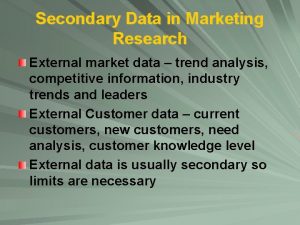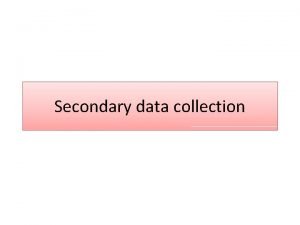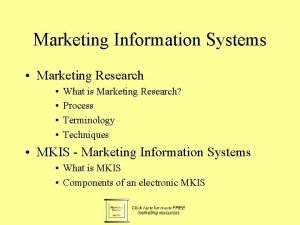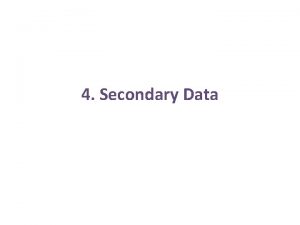Secondary Data in Marketing Research External market data












- Slides: 12

Secondary Data in Marketing Research External market data – trend analysis, competitive information, industry trends and leaders External Customer data – current customers, new customers, need analysis, customer knowledge level External data is usually secondary so limits are necessary

6 Principles of Secondary Data 1. Purpose 2. Accuracy 3. Consistency 4. Credibility 5. Methodology 6. Bias Careful evaluation of data leads to solid reports and high credibility of your report

Internal Secondary Data Common sources of internal data - sales invoices, accounts receivable reports, quarterly reports, sales activity reports, customer complaints and compliments Internal data although secondary is valuable because it is from your sales and your customers It is the best place to start

Planning for External Data GO-CART G – goals matching your search O – objectives – get as much secondary data as possible for a good selection C – Characteristics - list your topics to search to prevent getting side tracked A – Activities – Where will you search R – Reliability – back up your data with more than one source T - Tabulation – document all information collected

Variables in your search Demographics Employment characteristics Economic data Competitive Characteristics Supply Characteristics Regulations International market characteristics

Research Proposal How to write a research proposal

Research proposals take two forms 1. A marketing problem 2. A marketing opportunity A formal research proposal allows the researcher the opportunity to make sure that the research will provide the answer to the decision maker’s problem

Marketing Problem Brief description of general problem Show situation at the current time State goals, objectives and justification What question will be answer Address possible limitations Secondary data that will be sought Primary data you plan to collect Describe the sample size, questionnaire Time and personnel needed Costs for the study

Marketing Opportunity Describe the general opportunity Show situation at the current time / future State goals, objectives and justification What opportunity do you seek to answer Address possible limitations Secondary data that will be sought Primary data you plan to collect Describe the sample size, questionnaire Time and personnel needed Costs for the study

Structure of Research Proposal Executive summary – most important part since it is an overview of the proposal Problem Statement – What is the problem, the background, consequences, and the management question - state it clearly - only one problem not multiple issues Research Objectives – Purpose of the investigation - this is the research question - it should stand out clearly from the text

Method and Design - what methods will you use in your study, data sources, studies to be conducted, qualifications of researcher if deemed necessary Estimated Project Budget – usually covers wages, overhead costs, total fees, payment terms if necessary Schedule – time lines, major phases given, people required

Project Management Team- who will be doing the project and responsibilities Bibliography – show that it will be included for their reference use Appendices – usually includes a glossary, the measurement instrument and any other material you deem necessary Proposal should be done quickly to show the client your interest in the project.
 Primary target market and secondary target market
Primary target market and secondary target market Difference between primary market and secondary market
Difference between primary market and secondary market External market research
External market research Market leader challenger follower nicher
Market leader challenger follower nicher Objectives of segmentation
Objectives of segmentation Primary data
Primary data The terms external secondary data and syndicated
The terms external secondary data and syndicated Finer segmentation strategies
Finer segmentation strategies Marketing information systems and marketing research
Marketing information systems and marketing research Marketing information systems and marketing research
Marketing information systems and marketing research Marketing information systems and marketing research
Marketing information systems and marketing research Marketing information system kotler
Marketing information system kotler Marketing information systems and marketing research
Marketing information systems and marketing research























